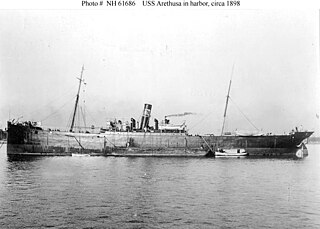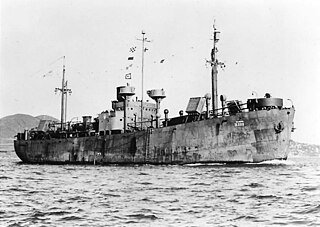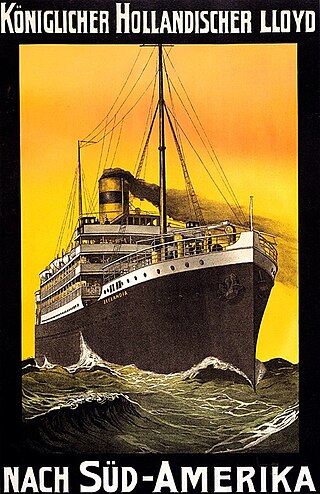
The first USS Abarenda (AC-13/AG-14) was a collier in the service of the United States Navy during World War I.

The first USS Pensacola was a screw steamer that served in the United States Navy during the U.S. Civil War.

USS Arethusa (AO-7) was a steamship that was built in England in 1893 as the civilian oil tanker Luciline. The United States Navy bought her in 1898, and later had her converted into a Fleet oiler. She was sold back into civilian ownership in 1927,and by 1928 she was a civilian hulk in Boston.

USS Duplin (AKA-87) was a Tolland-class attack cargo ship of the United States Navy, in service from 1945 to 1946. She was sold into merchant service in 1946 and finally scrapped in 1971.

USS Ajax (AC-14/AG-15) was a collier in the United States Navy. Originally she retained her previous name of Scindia, and was renamed for the mythical Ajax in 1901. In 1921, she became a receiving ship and was redesignated AC-14. She was reclassified as a seaplane tender and given the hull designator AG-15 in 1924.

USS Capella (AK-13) was a cargo ship in the United States Navy during World War II. She was named for Capella, the star.

USS Pegasus was built in 1939 as SS Rita Maersk by Helsingør Jernskibs og Maskinbyggeri A/A, Helsingør, Denmark. Following the outbreak of World War II in Europe, she sailed to the United States where she operated under charter from the Maritime Commission as Rita Maersk and later as Larwin. After completing two cruises, she was laid up at Boston, Massachusetts, until 18 September 1941 when she was acquired by the United States Navy from the Maritime Commission. Renamed USS Pegasus on 15 October 1941, the cargo ship was converted for U.S. Navy use by Sullivan Drydock and Repair Corporation, New York City, and commissioned at New York on 3 December 1941.

USS Brutus, formerly the steamer Peter Jebsen, was a collier in the United States Navy. She was built in 1894 at South Shields-on-Tyne, England, by John Readhead & Sons and was acquired by the U.S. Navy early in 1898 from L. F. Chapman & Company. She was renamed Brutus and commissioned at the Mare Island Navy Yard on 27 May 1898.

USS Glacier (AF-4) was a Glacier-class stores ship acquired by the U.S. Navy for use in the Spanish–American War. She served again during World War I in the dangerous North Atlantic Ocean, delivering general goods and ammunition to American Expeditionary Force troops in Europe.

USS Long Beach (AK-9) was a cargo steamship that was built in England in 1892 as Yarrowdale, passed through a succession of British, Greek and German owners, and was seized by the United States in 1917. She served in the US Navy until 1921, then in the US Merchant Marine, and was scrapped in 1924. She was called Nicolaos Castriotis in Greek ownership, Hohenfelde in German ownership, and Golden Gate from 1923.
USS Syrma (AK-134) was a Crater-class cargo ship commissioned by the U.S. Navy for service in World War II. She was responsible for delivering troops, goods and equipment to locations in the war zone.

USS Dewey (YFD-1) was a floating dry dock built for the United States Navy in 1905, and named for American Admiral George Dewey. The auxiliary floating drydock was towed to her station in the Philippines in 1906 and remained there until scuttled by American forces in 1942, to prevent her falling into the hands of the invading Japanese.

USS Nero (AC–17), a steel steam collier, was launched in 1894 as the steamer Whitgift by J.L. Thompson and Sons, Sunderland, England. The vessel was purchased on 30 June 1898 from McCondray and Co. at San Francisco and commissioned on 8 June 1898.

USS Zeelandia was an ocean liner that was built in Scotland in 1910 and scrapped in the Netherlands in 1936. She was the largest ship in the Koninklijke Hollandsche Lloyd (KHL) fleet from 1910 until the liners Gelria and Tubantia were completed in 1913 and 1914. She was USS Zeelandia from April 1918 until October 1919, when she was a United States Navy troopship.

USS General G. W. Goethals (ID-1443) was a German cargo liner that the United States seized during the First World War. She was launched in 1911 for the Hamburg America Line (HAPAG) as Grunewald. In 1917 the US seized her in Panama, and the Panama Canal Railway (PCR) operated her for the United States Shipping Board (USSB). In 1919 she spent six months in the United States Navy, in which she made three round trips to and from France to repatriate US troops. In 1920 the PRC bought her from the USSB. In 1925 the Black Star Line owned her. In 1926 the Munson Steamship Line bought her and renamed her Munorleans. She was scrapped in Scotland in 1937.

USS Rondo (ID-2488) was a Dutch cargo steamship that was built for Stoomvaart Mattschappij Nederland in 1914. She served in the United States Navy from March 1918 until June 1919. She was scrapped in 1933.

USS Oosterdijk was a Holland America Line cargo steamship that was built in 1913 and sank as a result of a collision in 1918. She served in the United States Navy, with the Naval Registry Identification Number ID–2586, from March 1918 until her loss that July. Some sources anglicise her name as Oosterdyk, but Lloyd's Register registered her with the Dutch spelling Oosterdijk.

SS Polar Chief was a merchant steamship that was built in England in 1897 and scrapped in Scotland in 1952. In her 55-year career she had previously been called Montcalm, RFA Crenella, Crenella, Rey Alfonso, Anglo-Norse and Empire Chief. Early in the First World War she spent eight months pretending to be the battleship HMS Audacious.

SS Ophir was a Dutch steamship that was built in 1904. She carried passengers, cargo and mail between Rotterdam and the Dutch East Indies until March 1918, when the United States seized her under angary and she became USS Ophir (ID-2800). In November 1918 a fire and explosion damaged her beyond economic repair. She was scrapped in 1922.

USS St. Francis (ID-1557) was a cargo steamship. She was built in Ireland in 1914 as San Francisco, and renamed St. Francis in 1918 when she was commissioned into the United States Navy. In 1933 she was renamed Lammot du Pont. In 1942 she was sunk by a U-boat, and 19 of her crew were lost.





















